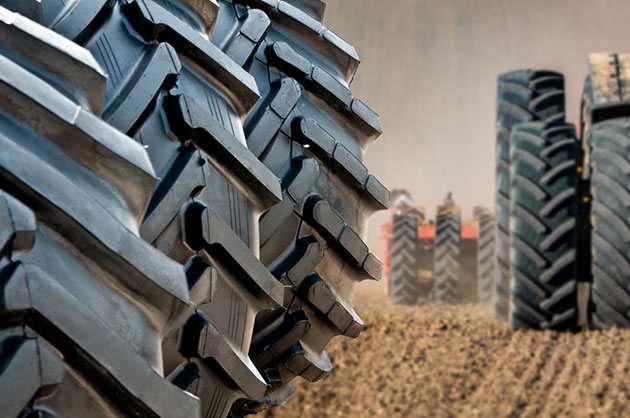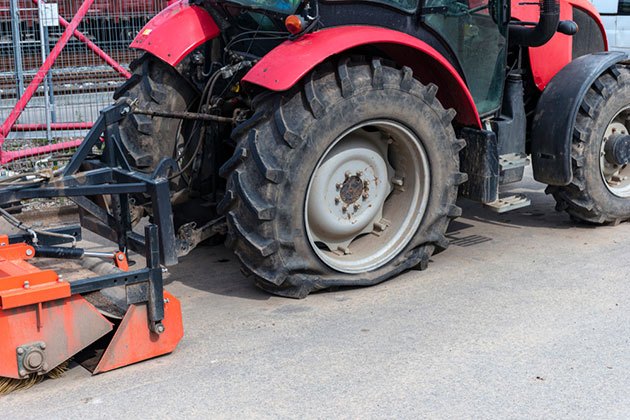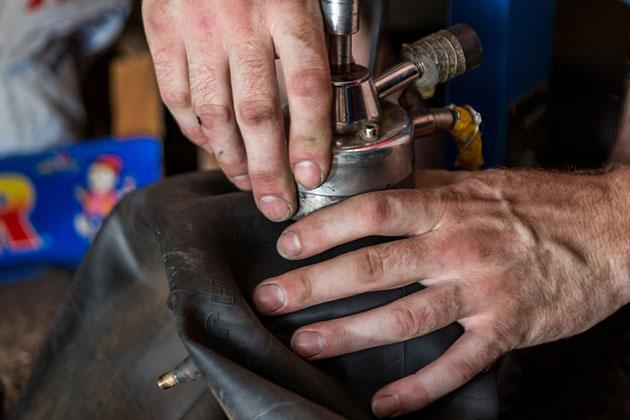You know that tractors are very robust agricultural machines, weighing more than 19,000 pounds.
So, how much do tractor tires weigh?
Well, you can expect that they’re hefty as well, to keep the machine stable and supported enough for numerous operations and agricultural tasks.
So, how much does a tractor tire weigh?
Well, the average weight of a tractor tire is between 400 and 600 pounds.
So, four-time each, you get up to 2,400 pounds of tire weight!
Still, let’s see what we’ve also prepared for you concerning tractor tire proportions and sizes.
You will also learn how to determine the proper tire weight of your tractor.
Table of Contents
What Are the Standard Measurements of Tractor Tires?

Luckily, you don’t have to perform the heavy lifting to find how heavy your tractor tires are. However, you need to know that they come in two major groups:
- lightweight tractor tires
- heavyweight tractor tires
Now, it’s crucial to remember that these groups have four major subgroups, including:
- compact size tractor tires
- medium/mid-sized tractor tires
- large tractor tires
- extra large tractor tires
1. Compact size tractor tires
What’s so unique about these tractor tires?
Firstly, they measure 17.5x25ft. Their maximum weight is estimated at 300 pounds.
However, you can consider them lighter, as the average weight of a car tire measures 25 pounds.
And, even when you compare various heavy-duty vehicles, similar to tractors, you can notice that their tires weigh around 200 pounds each.
So, there’s no mistake that the average tractor has a tractor tire weighing around 300 pounds (or even more!)
2. Medium/mid-sized tractor tractor tires
Medium tractor tires are the next category, measuring 20x25ft.
However, their maximum weight measures 400 pounds or slightly more.
As you see, medium tractor tires are not bigger than small tires; thus, they don’t add weight to your tractor size and weight.
3. Large tractor tires
A large tractor tire is more substantial than the previous two categories.
They’re massive due to their 23.5×25 feet proportions. Thus, the tire weight might vary between 400 and 8000 pounds at maximum.
Yet, some more substantial tire weights can also be slightly lighter. Thus, they can vary between 550 and 650 pounds.
So, the tire weight matching this size is determined by metal parts and wear patterns.
4. Extra-large tractor tires
Finally, the last category in the colossal tire weight measures 26.5×25 feet. Don’t be surprised when you realize they weigh 1,000 pounds each!
Thus, the heavy tires weigh around 4,000 pounds on your tractor!
It’s insane, you’ll agree!
Determining the Weight of Your Tractor Tires

Naturally, you want to determine how much your tractor tires weigh, but how do you calculate the weight correctly?
As previously said, you don’t have to calculate by yourself, let alone detach them one by one, and measure.
The average tractor tire is too sizable for the process. So, you can stick to the following procedure:
Firstly, fire the sidewalls of your tractor tire. You should find a 5-digit number on it.
Now, once you do, you’ll see that the first two digits are separated by a period. Moreover, the last two digits should have a dash between them.
An example would be 16.9-30.
Hence, the 16.9 refers to the tractor tire’s width from one tire’s sidewall to another. The width is measured in inches.
Number 30 represents the diameter of the tire’s rim, also measured in inches.
Now, it would be ideal to stop here. Nevertheless, there are further explanations necessary for your tractor tire.
Namely, they can be:
- standard sizes
- radial tractor tires
- metric tractor tires.
1. Metric tractor tires
A metric tractor tire refers to the European tire, based on its measurement system and tire weight.
You can recognize the metric measures because the tire will have a letter R and a slash or maybe two. Such examples refer to 420/85R24 or 280/85R20.
The first number means the tractor tire’s width when it’s correctly mounted and inflated to understand the digits better.
However, if the integer is small, it’s represented in millimeters instead of inches.
The next digit refers to the aspect ratio.
The aspect ratio includes the tire width percentage to its height when correctly mounted and inflated.
So, once again, The number will be smaller, expressed in millimeters, not in inches.
And the letter R refers to the radial construction. The radial construction is standard in metric tractor tires.
Finally, the number after the radial construction – R represents the wheel diameter for mounting.
2. Radial tractor tires
A radial tractor tire also has radial construction posted on the sidewall.
The R means the radial tractor tires have 90-degree cord piles, moving in the same direction as the tractor tires.
Also, most tires will be radial, but not always.
In addition, the radial tractor tire contains two numbers separated by a period, followed by another number, R, and again two numbers following.
So, for instance, you can find 18.4R26 or 11.2R20.
3. Standard tractor tires
To understand these tires better, refer to the first example we have used in this section. It’s standard for this tire type.
But, if you find different expressions for tire sizes, such as 16.9X28 or 11.2X20, don’t be too perplexed – these are just alternatives for the same terms on the sidewall.
However, it’s possible to convert from one tractor size to another.
You can easily refer to the Ken Jones Tires conversion chart to do so correctly.
Still, every blank spot means that there’s no correct conversion to particular tire sizes.
| STANDARD | RADIAL | METRIC |
| 11.2X30 | 11.2R20 | 280/85R20 |
| 12.4X20 | 12.4R20 | 320/85R20 |
| 9.5X24 | 9.5R24 | 250/85R24 |
| 11.2X24 | 11.2R24 | 280/85R24 |
| 12.4X24 | 12.4R24 | 320/85R24 |
| 13.6X24 | 13.6R24 | 340/85R24 |
| 14.9X24 | 14.9R24 | 380/85R24 |
| 16.9X24 | 16.9R24 | 420/85R24 |
| 18.4X26 | 18.4R26 | 420/85R26 |
| 11.2X28 | 11.2R28 | 280/85R28 |
| 12.4X28 | 12.4R28 | 320/85R28 |
| 13.6X28 | 13.6R28 | 340/85R28 |
| 14.9X28 | 14.9R28 | 380/85R28 |
| 16.9X28 | 16.9R28 | 420/85R28 |
| 14.9X30 | 14.9R30 | 380/85R30 |
| 16.9X30 | 16.9R30 | 420/85R30 |
| 420/90R30 | ||
| 18.4X30 | 18.4R30 | 460/85R30 |
| 12.4X32 | 12.4R30 | 320/85R32 |
| 12.4X34 | 12.4R34 | 320/85R34 |
| 14.9X34 | 14.9R34 | 380/85R34 |
| 16.9X34 | 16.9R34 | 420/85R34 |
| 18.4X34 | 18.4R34 | 460/85R34 |
| 20.8X34 | 20.8R34 | 520/85R34 |
| 12.4X36 | 12.4R36 | 320/85R36 |
| 13.6X36 | 13.6R36 | 340/85R36 |
| 13.6X38 | 13.6R38 | 340/85R38 |
| 14.9X38 | 14.9R38 | 380/85R38 |
| 16.9X38 | 16.9R38 | 420/85R38 |
| 18.4X38 | 18.4R38 | 460/85R38 |
| 20.8X38 | 20.8R38 | 520/85R38 |
| 18.4X42 | 18.4R42 | 460/85R42 |
| 20.8X42 | 20.8R42 | 520/85R42 |
| 20.8X46 | 20.8R46 | 520/85R46 |
Therefore, you should refer to the conversion chart above to find the right size of your tires, but if you still are uncertain how to measure the correct size correctly, you can ask tractor experts.
Tips & Tricks on Keeping Your Tractor Tire Optimal

As we know, tires are an essential part of tractors, and we cannot imagine any farm equipment without them.
So, once you determine the size of your four tires, you want them to last for a couple of years, without additional complicated conversions too soon.
Thus, it would be best to keep your four tires in different shapes and top condition for more robust uses and a longer lifespan.
And how to do so? Well, you can…
1. Clean the tractor tire often
If you have a farm tractor, you will undoubtedly use it on a daily basis.
Thus, the tractor will gather dirt underneath and on the construction. However, the tires will be the first to get dirty.
So, when you notice your tires are too dirty, wash them. How?
Apply a tire brush, soap, and water. Next, get in the tire’s groove and clean all the way to the tire’s bottom part. Next off, let your tire completely air dry.
Clean tires will be better for a ride, and you can easily extend their quality and lifespan.
2. Purchase quality tires
When picking the best tractor tire, you may likely spend several hundred for each tractor tire, but it doesn’t mean the tractor tire will be as good as it should be.
So, to avoid the tire falling apart or damaging too soon, you should invest in a premium-quality tire that will last for an extended period without harming quickly.
Although it might be difficult for your budget, it is still the best solution to purchase a high-quality tire to avoid all sorts of tire issues and potential risks.
3. Don’t drive on a pavement
Your tractor might handle a little pavement, but not too much – do not forget that.
So, keep in mind that tractor and truck tires are not the same!
Thus, you should limit your pavement driving to a minimum or eliminate it.
The tire weight is mainly intended for transporting different materials and operating on softened terrains, including hay, grass, or dirt.
Another reason is that in some states, such as Pennsylvania, the law forbids you to drive tractors on streets unless you title your vehicle first.
4. Replace the tires often
If you notice your tire is too old and in bad condition, an instant replacement is the best solution for your tractor.
You will reduce the potential risks whenever you drive your tractor.
Also, your tractor tire can pop whenever you hit debris and pointy stones.
So, due to proper tire size, width, and tire weight, you will definitely feel it when driving the tractor.
So, if your wheels slip more than usual, it’s time to replace the old tires with the new ones.
Unless the weather conditions are too wet, the wheels and tires should not slip like that.
If you fill-up the tire and notice it cannot maintain the pressure, it’s time for a replacement.
Also, your tires may dry rot. So, if your tractors are overexposed to the sun, it may cause material cracks and lose elasticity.
Hence, do not expose your tractors and tires to the sun and dry air.
However, you might also find the tire brittleness, paleness, or tire fading. Therefore, these are the main signs you must replace your tires instantly.
5. Improve storing conditions
To keep your tractor tires in excellent condition, you need to store them in specific airtight places.
Thus, you can prevent the evaporation of the lubricating oil within the tractor tire.
You can use various premium airtight plastic bags from different supply shops near you, including lawn or garden bags.
And when placing the tire inside the bags, ensure you release as much air as possible, and secure the bags with tapes.
6. Place the tires upright
The replacement tires for tractors should not be stacked or lying down.
Instead, it would be best if you placed them properly upright.
And, in case you need to stack them, don’t stack the tires too high. They might be damaged by falling.
However, when storing the tires, ensure they’re in a dry and cold place, avoiding direct sunlight.
A black tire might absorb the rays and heat up to 120F degrees. At this high temperature, it can tear inside or break down quickly.
Read more —
Learn How To Drive Safely With The Best Tractor Tire Chains (Top 6 Picks)
FAQs
How heavy should the tire be for flipping?
A tractor tire should be at least 20 inches thick to allow the athlete to perform well in the optimal flip-tire position.
Otherwise, a thinner tire will only enable a sumo-deadlift lifting position, famous as the biceps-tearing position.
How much does a semi-truck tire weigh?
A typical semi tire weight measures around 110 pounds.
The main reason for this weight is that semi-trucks better handle the more challenging road conditions, and their durability reflects in the heavier semi-tire weight.
What kind of tires do tractors use?

Tractors use the following tire types:
- Agricultural Tractor Tires (R1)
- Turf Tractor Tires (R3)
- Industrial Tractor Tires (R4)
The R1 type is ideal for fieldwork primarily.
The R3 type is the best solution for lawn mowers and gold cars.
Finally, the R4 tires are the most convenient on different construction sites, specifically forklifts.
How do I know if my tractor tire is biased or radial?
A radial tractor tire has a two-part construction, allowing the tire sidewall to flex independently of the thread area or face of the tire.
On the other hand, the bias tractor tire is created with a single-ply wrapped diagonally from one side to another.
How much does an 18 wheeler tire weigh?
The tire weight may vary due to the wheel materials and their weight.
Thus, the wheel – the metal part may weigh around 30-50 pounds for a standard trailer or a tractor-sized vehicle.
However, when you add a tire, the situation changes.
Thus, the weight might reach 100 pounds if the tire is new.
But, according to the tire’s diameter, height, and size, the weight will also vary.
And we have seen that the weight goes from around 100 pounds for semi-trucks to 1,000 pounds for extra-large tractors.
Summary
So, how much does a tractor tire weigh?
They may weigh around 300 to 1,000 pounds based on the tire size.
Their weight must also match your tractor’s weight and size, so it would be best to learn the tractor’s size and weight as well and fit them correctly.
However, you have already seen how to correctly measure the tire weight with the given number on the sidewall.
Still, when you know these digits, they will be valuable for adding extra weight if you need to improve your tractor’s traction and perform better in various lawn tasks, as well as on a regular basis.
Thus, make sure you find the weight specifications in the size chart given above and follow the proportions for the correct sizes.
And, if you have additional questions, dilemmas, or other difficulties, comment below – I’ll gladly help you solve them.
